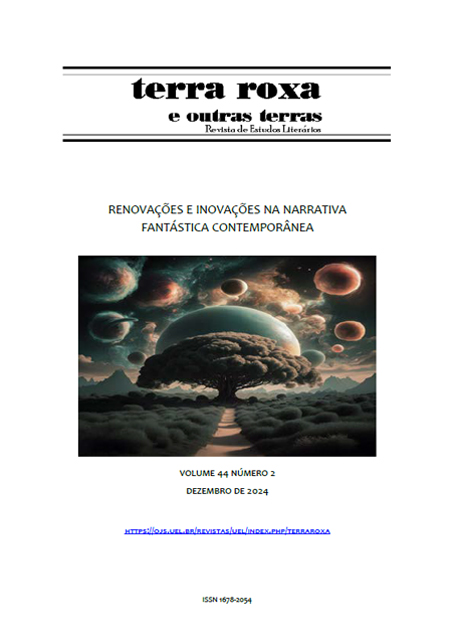Violence, Uncanny and Reparation in "La Llorona" (2019), by Jayme Bustamante
DOI:
https://doi.org/10.5433/1678-2054.2024vol44n2p106Keywords:
uncanny, genocide, violence, La LloronaAbstract
This article aims to analyze the reconfiguration of the figure of La Llorona in the 2019 film of the same name, directed by Jayme Bustamante, by examining the intersection of historical violence and elements of the fictional uncanny. The film presents a fictional reconstruction of a key episode in Guatemalan history: the trial of former dictator Monteverde for his crimes against the Ixil Maya population, who were decimated under his totalitarian regime. In this context, the figure of Alma, a mythical representation of La Llorona, emerges to haunt the military officer for the atrocities committed against her community. Despite his guilt, the former dictator evades legal punishment, but he is confronted by a series of uncanny occurrences that serve as a catalyst for justice, offering a symbolic response to the violence inflicted by the State. This analysis draws on the works of Rafael Cuevas Molina (2012) and Grace Bushway (2021) regarding violence and cinema in Guatemala, as well as the theoretical contributions of Rosa M. E. de Montandon (2007), Ana Lúcia Trevisan (2017), and Filipe Furtado (1980) to explore the figure of La Llorona and the construction of the uncanny in Bustamante’s film.
Downloads
References
BUSHWAY, Grace. Verdad y responsabilidad: los ejes nuevos de la memoria en el cine contemporáneo de Guatemala. Pennsylvania: The Cupola Gettysburg College, 2021. Disponível em: https://cupola.gettysburg.edu/student_scholarship/911 .
CUEVAS MOLINA, Rafael. De Banana Republics a repúblicas maquileras. San José: EUNED, 2012.
FAQUERI, Rodrigo de Freitas. A estética da violência na literatura centro-americana contemporânea: um estudo sobre as narrativas do guatemalteco Rodrigo Rey Rosa. Tese (Doutorado em Letras) – Universidade Presbiteriana Mackenzie. São Paulo, 2018. Disponível em: http://dspace.mackenzie.br/handle/10899/25212.
FURTADO, Filipe. A construção da narrativa fantástica. Lisboa: Livros Horizonte, 1980.
LEÓN-PORTILLA, Miguel. Visión de los vencidos: Relaciones indígenas de La Conquista. México DF: Coordinación de Publicaciones Digitales, 2007.
MONTANDON, Rosa Maria Spinoso de. La Llorona - mito e poder no México. Tese (Doutorado em História) – Universidade Federal Fluminense. Niterói, 2007. Disponível em: https://www.historia.uff.br/stricto/teses/Tese-2007_MONTANDON_Rosa_Maria_Spinoso-S.pdf.
OLEA FRANCO, Rafael. En el reino de los aparecidos: Roa Bárcena, Fuentes y Pacheco. México: El Colegio de México, 2004.
REY ROSA, Rodrigo. El material humano. Barcelona: Anagrama, 2009.
TORRES-RIVAS, Edelberto, coord. Historia General de Centroamérica - Historia Inmediata (1979-1991). Tomo VI. Madrid: FLACSO / Siruela, 1993.
TREVISAN, Ana Lucia. Imagens do insólito e do maravilhoso: construções da historicidade na literatura hispano-americana. A Cor das Letras, Feira de Santana, v. 15, n. 1, p. 11–26, 2017. Disponível em: https://doi.org/10.13102/cl.v15i1.1427. DOI: https://doi.org/10.13102/cl.v15i1.1427
ZARATIN, Daniele Aparecida Pereira. Perspectivas do insólito ficcional: uma análise dos romances de Gioconda Belli e María Amparo Escandón. 2019. Tese (Doutorado em Letras) – Universidade Presbiteriana Mackenzie. São Paulo, 2019. Disponível em: http://dspace.mackenzie.br/handle/10899/25217.
Downloads
Published
How to Cite
Issue
Section
License
Copyright (c) 2024 Rodrigo de Freitas Faqueri, Daniele Aparecida Pereira Zaratin

This work is licensed under a Creative Commons Attribution 4.0 International License.
Authors who publish in this journal agree to the following terms:
a) The authors retain the copyright and grant the journal the right of first publication, the work being simultaneously licensed under the Creative Commons Attribution-NonCommercial 4.0 International License, allowing the sharing of the work with acknowledgment of the authorship of the work and initial publication in this journal.
b) Authors are authorized to assume additional contracts separately, for non-exclusive distribution of the version of the work published in this journal (eg, publish in an institutional repository or as a book chapter), with acknowledgment of authorship and initial publication in this journal.
c) Authors are allowed and encouraged to publish and distribute their work online (e.g. in institutional repositories or on their personal page) after the editorial process, as this can generate productive changes as well as increase impact and citation of the published work (See The Effect of Open Access).
d) The authors of the approved works authorize the journal to, after publication, transfer their content for reproduction in content indexers, virtual libraries and the like.
e) The authors assume that the texts submitted for publication are of their original creation, taking full responsibility for their content in case of any objection by third parties.



















